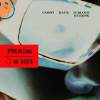
It’s hard to shake the impression that Imagine Dragons are working a formula, wheeling out variations on a clearly winning theme: those ponderous distortodrums, the extreme arrangement dynamics, the howling vocal-throng hooks, and singer Dan Reynolds’ trademark triplet-hemiola verse riffing. No shade on them, though – if it ain’t broke…
What increasingly draws me to their songs, though, is the fastidiously creative production and mixing work, and specifically all the things in the background that cleverly support the hit template’s foreground features. Take the hugeness of the chorus entry here, for instance. Yes, the sonics on their own are impressive, and there aren’t many productions outside the EDM space that can give ‘Enemy’ a run for its money in terms of pure downbeat impact. But sheer sonics only tell part of the story, because the sense of power here is delivered at least as much by a combination of more psychological tactics.
The production’s very first hit is a case in point. Although the super-tight drum/horns hit is impressive on its own, there are two good reasons why it’s enhanced by the rising synth-note transition effect that precedes it. Firstly, the synth sets a spectral frame of reference that’s quite dull and bandwidth-restricted, so the hit’s extended frequency extremes are more startling by comparison. And secondly, the rising amplitude and pitch profiles naturally set up an expectation of the forthcoming event, which intensifies the hit’s pay-off of that expectation. But also listen carefully after the hit’s landed too, and you’ll hear something like amplifier noise rising up at the end of the hit’s decay tail, the psychological implication being that the listener is close enough to hear that subtle noise (and that the band’s gear is turned up loud enough to generate it), but that the hit was so loud by comparison that it’s taken the listener’s ears a while to recover from it – or, alternatively, that some kind of intervening dynamics processing is struggling to recover its gain reduction following some earth-shattering signal peak.
The use of low-energy vocal moments works in a similar way. At 0:55, Reynolds suddenly shifts down to a near-whispered delivery for “but I’m ready”, again implying by its nearness and intimacy that more strongly sung vocals on either side must be louder than they actually are. But my absolute favourite moment here is the little “huh” just before the second chorus, which takes this concept to the extreme, amplifying to audibility something you’d normally expect to be scarcely audible, and just before the peak-loudness moment of the chorus downbeat. The final drop-chorus entry at 2:12 is also fabulous, with the a-capella moment first shocking the ear with the loudest vocal presentation in the production, but then the more spectrally restrained backing “oh” interjection resetting the framing (in a similar way that the bass note did at the start of the song) so that the subsequent hit can still pack a mighty perceptual punch. It’s masterfully managed, and it’s somehow a shame that it was dropped from the later version of the song the band released with rapper JID. (Although it’s a great rapped performance too, to be fair.)
And the framing contrasts don’t just happen between different timeline moments – they’re also occurring during the ongoing verse and chorus textures. Specifically, I’m referring to what’s going on in the background behind the main beat and vocals. There’s so much going on in this respect, but some highlights for me include: the fizzing ‘short circuit’ sound effects tangled up with high-pass filtered synth squelches during the verses (check out the stereo Sides signal to hear them better); and the almost classical-sounding choral exclamations during the choruses that are frequently only audible by dint of their reverb signature; the deep gain-pumping of the bass synth in response to the chorus hits; the huge reverbs on the prechorus backing vocals and the subtle high chime that arrives in the second verse, both of which suggest a vast environment – a bit like dropping a torch down a mineshaft!
This is production and mixing work of the highest calibre, and worthy of careful examination by any serious student of mainstream music production.










